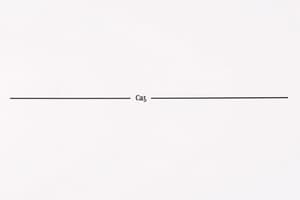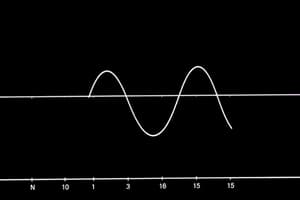Podcast
Questions and Answers
What is the integrated rate law expression for a second-order reaction?
What is the integrated rate law expression for a second-order reaction?
- [A] = [A]_0 - kt
- ln[A] = ln[A]_0 - kt
- t_{1/2} = k[A]_0
- 1/[A] = 1/[A]_0 + kt (correct)
What does the half-life of a zero-order reaction depend on?
What does the half-life of a zero-order reaction depend on?
- The temperature alone.
- The activation energy.
- Only the rate constant.
- The initial concentration and the rate constant. (correct)
In the context of the Arrhenius equation, what does the symbol $E_a$ represent?
In the context of the Arrhenius equation, what does the symbol $E_a$ represent?
- The equilibrium constant.
- The universal gas constant.
- The activation energy. (correct)
- The rate constant.
Which of the following equations represents the half-life for a first-order reaction?
Which of the following equations represents the half-life for a first-order reaction?
What is the form of the rate equation for a zero-order reaction?
What is the form of the rate equation for a zero-order reaction?
For a first-order reaction, how does the natural logarithm of the concentration change over time?
For a first-order reaction, how does the natural logarithm of the concentration change over time?
What occurs to the rate constant $k$ as the temperature increases, based on the Arrhenius equation?
What occurs to the rate constant $k$ as the temperature increases, based on the Arrhenius equation?
Which of the following expressions correctly represents the half-life of a zero-order reaction?
Which of the following expressions correctly represents the half-life of a zero-order reaction?
In a second-order reaction, how does the concentration relate to time according to the integrated rate law?
In a second-order reaction, how does the concentration relate to time according to the integrated rate law?
How does the activation energy $E_a$ affect the rate constant $k$ according to the linear Arrhenius form?
How does the activation energy $E_a$ affect the rate constant $k$ according to the linear Arrhenius form?
Flashcards
Reaction Rate
Reaction Rate
The change in concentration of a reactant over time, measured in units of molarity per unit time (e.g., M/s).
Rate Law
Rate Law
A mathematical expression that relates the rate of a reaction to the concentrations of reactants. It includes a rate constant (k) and exponents for each reactant (m, n).
Half-Life
Half-Life
The time it takes for the concentration of a reactant to decrease to half its initial value.
Arrhenius Equation
Arrhenius Equation
Signup and view all the flashcards
Integrated Rate Laws
Integrated Rate Laws
Signup and view all the flashcards
Study Notes
Reaction Rates and Integrated Rate Laws
- Reaction Rate: The rate of a reaction is expressed as the change in concentration of a reactant or product per unit time. The equation is: d[A]/dt = k[A]^m[B]^n, where k is the rate constant, [A] and [B] are reactant concentrations, and m and n are the reaction orders (typically integers).
Zero-Order Reaction
- Integrated Rate Law: [A] = [A]0 - kt (where [A]0 is the initial concentration of A)
- Half-life: t1/2 = [A]0 / 2k
First-Order Reaction
- Integrated Rate Law: ln[A] = ln[A]0 - kt
- Half-life: t1/2 = 0.693 / k
Second-Order Reaction
- Integrated Rate Law: 1/[A] = 1/[A]0 + kt
- Half-life: t1/2 = 1 / k[A]0
Arrhenius Equation
- Equation: k = Ae-Ea/RT
- describes the temperature dependence of the rate constant, k, where:
- A = pre-exponential factor
- Ea = activation energy
- R = ideal gas constant
- T = absolute temperature
Linear Arrhenius Form
- Equation: ln k = -Ea/RT + ln A
- This form of the Arrhenius equation allows for determination of activation energy by plotting ln k vs 1/T.
Integrated Rate Laws (Summary)
- Zero-Order: [A] = [A]0 - kt
- First-Order: ln[A] = ln[A]0 - kt
- Second-Order: 1/[A] = 1/[A]0 + kt
Studying That Suits You
Use AI to generate personalized quizzes and flashcards to suit your learning preferences.





